Eyeing the Assembly elections in 2023, tribal-based parties in Tripura and Meghalaya have renewed their demand to create separate states for the indigenous tribals, even as the major political parties continue to strongly oppose their claims.
Tribals constitute over 86 per cent of the total population in Meghalaya, while in Tripura, they account for 31 per cent of the population. The Assembly elections in the two northeastern states are scheduled in 2023.
Advertisement
The ruling BJP’s junior ally, the Indigenous People’s Front of Tripura (IPFT), and the Hill State People’s Democratic Party (HSPDP), which is a part of the ruling National People’s Party-led Meghalaya Democratic Alliance, have been spearheading the separate state agitation in the two states.
The IPFT has been agitating since 2009 for the creation of a separate state by upgrading the politically important Tripura Tribal Areas Autonomous District Council (TTAADC), which has jurisdiction over two-thirds of Tripura’s 10,491 sq km area and is home to over 12,16,000 people, of which 90 per cent are tribals.
Though the IPFT on its own has organised violent and vigorous movements to push its separate state demand during the past 12 years, the party on Saturday held a crucial meeting with many other tribal-based parties, NGOs and prominent tribal leaders to take forward the demand in a forceful manner.
The IPFT’s new strategy, according to political pundits, was designed as the party suffered a major setback after failing to secure any seat in the April 6 elections to the 30-member TTAADC.
The newly-formed Tiprahaa Indigenous Progressive Regional Alliance (TIPRA) headed by Pradyot Bikram Manikya Deb Barman, head of the erstwhile Royal house of Tripura, captured the TTAADC in April by winning 18 of the 28 seats for which elections were held.
The TIPRA scripted history in the northeastern state by capturing the TTAADC, which is considered as a mini-legislative assembly of Tripura, after raising the demand of ‘Greater Tipraland’ even as the demand triggered huge doubts and fears in the mixed populated Tripura ever since the newly-formed party raised the demand in 2019.
After TIPRA captured the TTAADC, a unanimous resolution was recently passed in the council and it was subsequently sent to the Governor, the state government and the Centre to create a Greater Tipraland.
“Under the Greater Tipraland concept, a powerful council would be constituted for the all-round socio-economic development of the indigenous tribals residing in the eight northeastern states and the neighbouring countries, including Bangladesh. Such councils exist in European countries. We want to resolve the tribals’ basic problems permanently,” Deb Barman told IANS.
He said that Greater Tipraland is only for the protection of the tribals and their socio-economic development and the demand is not against any non-tribal community, neither political nor is it vote bank politics.
“This is purely for the upliftment of a backward community,” he said, adding that his party wants the development of the tribals residing in the entire northeast region and the neighbouring countries.
Deb Barman, who also attended Saturday’s meeting called by its opponent party IPFT, said: “We have to put our people’s interest above personal and party interest… We won’t compromise on our aims and objectives as long as I am the leader of TIPRA.”
IPFT General Secretary and Tripura’s Tribal Welfare Minister Mevar Kumar Jamatia said that the meeting was held with five like-minded parties, NGOs and prominent tribal leaders to intensify the full-fledged statehood demand (Tipraland) and introduction of the National Register of Citizens (NRC) in Tripura to protect the socio-economic interest of the indigenous tribals.
“If proper protection is not taken, the tribals’ socio-economic and traditional life and culture would be ruined. Hence, a separate territory for the native tribals is a must,” Jamatia said.
Last week in Meghalaya, the Hill State People’s Democratic Party (HSPDP), which is an ally of the National People’s Party-led Meghalaya Democratic Alliance, and the Garo Hills State Movement Committee (GHSMC) formed a coordination committee to intensify their claim for the proposed separate Khasi-Jaintia and Garoland states splitting the hill state.
HSPDP President K.P. Pangniang said that after the bifurcation of Meghalaya, one state will be for the Garos and the other for the Khasi-Jaintia communities.
“Demarcation of the boundaries between the two proposed states would be finalised so that no problems surface in the future, similar to the existing inter-state problems between Assam and Meghalaya,” he said.
The tribal leader said that the coordination committee would identify and demarcate the areas that would fall in the two proposed states, and booklets in local languages would be released soon to explain their demand for the creation of separate states.
The GHSMC, a conglomerate of seven Garo organisations, including regional party Garo National Council, along with the HSPDP have also decided to launch a joint movement to intensify their demand for the bifurcation of Meghalaya.
The GHSMC had in December 2018 raised the demand for a separate Garoland after several extremist outfits also voiced similar demand. Many former militant leaders are also part of this renewed movement.
Meanwhile, the demand for the creation of Garoland comprising western Assam’s four districts — Chirang, Baksa, Udalguri and Kokrajhar — inhabited by the matrilineal Garo community, once became a major issue in Assam when the Bodoland statehood movement was at its peak.
The Bodoland issue was more or less tamed after the Bodoland Territorial Region accord was signed between the Centre, Assam government and Bodo dominated parties in January 2020, with 1,615 extremists laying down their arms before the government.
The Garo Hills region, comprising five of Meghalaya’s 11 districts and 24 out of 60 Assembly seats, is spread across 10,102 sq km. As per the 2011 Census, this region had 13.94 lakh, people, compared to the 22.44 lakh spread across the Khasi-Jaintia Hills region covering 15,546 sq km.
In 2014, the Meghalaya Assembly had rejected the demand for the creation of a separate Garoland in the western part of the state.
Khasi tribals constitute more than half of the total tribal population of the state (56.4 per cent) while Garo is second with 34.6 per cent. They together constitute 91 per cent of the total tribal population of 26 lakh out of the state’s total population of three million (2011 Census).
The BJP, Congress, CPI-M and all other major political parties have separately rejected the separate state demands in Tripura and Meghalaya.











